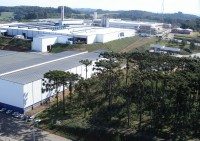Marangoni aims to make European retreading more competitive
Compared with producing a new tyre, retreading saves up to 30 per cent in energy and 70 per cent in raw materials. Retreading also lowers overall cost per kilometre, but despite these benefits the European retreading market has been hampered by a scarcity of the industry’s main raw material – good quality, retreadable casings – and by the availability of new imported tyres whose casing quality is not sufficient for retreading.
Europe’s retreading sector has been essentially stable in recent years, with production volumes between 5.5 and 6 million tyres a year and a fairly even balance between the pre-cure and mould cure retreading processes. A growth in Eastern European markets has offset a decline in Western Europe, primarily in markets where a scarcity of suitable casings has penalised retreading.
Declining unit sales in Europe’s new truck tyre replacement market have slightly increased the market share held by retreaded tyres, however it remains much lower compared with some markets, particularly North America. Comparing data for the two regional markets shows that while there are four retreaded tyres in service for every ten new truck tyres in Europe, in North America there are nine retreads for every ten new truck tyres.
To gain a greater understanding of the reasons behind this sizable variation in retread use within these two important markets, our Italian affiliate publication PneusNews spoke with several senior Marangoni Group managers; Angelo Priori (R&D director), Paolo M. Fincato (development and communication director), Giuseppe Magistrale (pre-cured product manager), and Silvano Turella (technical services manager).
Angelo Priori says that, based on the experience the company has acquired in these two markets, “the difference in ratio depends on various factors. Firstly, we need to recognise the different types of applications and tyre usage conditions in the North American market compared to the situation in Europe. We know that new and retreaded tyre consumption in North America is mainly created by the long trailers commonly used there, which are almost always fitted with twin wheels, and cover mileages that are not especially hard on the casings. The situation in Europe is different, where drive axle tyre consumption is higher, both due to vehicle and trailer configuration – most use supersingles – and due to the type of routes travelled, often in less than optimal operating conditions due to climatic differences. Another significant factor is average fleet size. These are much smaller in Europe, and consequently so is the importance attributed to maintenance and efficient tyre management.”
Paolo M. Fincato adds: “Another major factor is the average size of retreaders and the resulting differences in productivity and attention to quality. Average annual production output for a North American retreader (there are around 700 retreaders there in total; these retread a total of 15 million tyres each year) is approximately 22,000 tyres. This load factor is quite evenly distributed and represents a relatively limited combination of sizes and patterns. In Europe, 6 million tyres are retreaded by around 500 retreaders each year; each produces around 12,000 tyres a year, a number that decreases even further to around 10,000 a year if excluding some of the larger mould cure retreading plants. Moreover, the combination of sizes and profiles tends to be more complex in Europe, an aspect that negatively affects retreaders’ productivity. If we then add the fact that, in our market, product cost is typically the main decider, the quest for short-term savings sometimes means insufficient attention is paid to the total cost of tyre ownership and how this can be improved by quality retreading.
“In addition to these factors, and as recently highlighted in a study conducted by the ETRMA, we also need to remember that as things stand, there is no single legislative framework concerning the status of casings used for retreading as either waste or products, and the rules that need to be observed for transporting and storing them,” Fincato observes. “In some cases, this situation complicates and penalises a crucial stage in the process, that is, the collection and selection of casings for retreading. We should not be amazed then that very often, used tyres that would normally be suitable for retreading end up being exported from Europe, depriving our market of a valuable resource.”
On the subject of legislation, Angelo Priori also notes that a legal requirement for driving in California is that all heavy goods vehicles must be fitted with tyres, either new or retreaded, that fall within clearly defined limits of rolling resistance. Priori comments that these limits are periodically tested using the same tests that Marangoni performed on its RingTread system retreads. He adds: “As we know, in Europe retreaded tyres are currently exempt from labelling requirements, however the relevant associations are working to identify standard solutions that, despite applying to different manufacturing conditions (product specifications and production processes) from those used to make new tyres, can be used to measure and define the performance of retreaded tyres, given the importance that the use of these tyres has and will continue to have.”
Marangoni’s managers raise the point that, while new tyre manufacturers can typically control all the factors associated with their materials and processes, independent retreaders have a rather more difficult task, given that they need to deal with numerous variables (such as casings, tread and retreading processes), hence a need exists to verify the interaction between these and their impact in terms of finished product performance and measurability.
A further comment from Marangoni is that, in order to increase sales of retreads and the proportion of new tyres being retreaded in Europe, certain conditions that are currently lacking or only present in part need to be consolidated, and this should help make retreading more regulated and efficient and also improve retreaded tyres’ quality and perceived image, hence encouraging end users to select these products.
PneusNews then asked what concrete contribution a company like Marangoni can make to improve the European retreading industry’s competitiveness and quality in light of the experience it has acquired in the North American market, where retreaders have for some time faced competition from imported Asian tyres. Giuseppe Magistrale answers that “Marangoni Retreading Systems has contributed to retreading, in terms of quality and competitiveness, through the two mainstays of its product portfolio. These are the RingTread and the retreading technology developed over the years to make tyre retreading using the ring system increasingly efficient.
“The circular configuration and the absence of joints means RingTread adheres perfectly and naturally to the casing without any stress or deformation during application, thus reducing the retread’s rolling resistance and making the production process more efficient, reducing building and vulcanisation time, and waste. With the recent introduction of the new range of BlackLine rings, featuring original tread profiles designed for more demanding uses, low-heating compounds, minimum abrasion and high resistance, a good quality casing retreaded with the BlackLine RingTread system ensures a level of performance that rivals and even surpasses that of new tyres.”
Regarding the retreading process itself, Marangoni’s greatest advance was made with the introduction of the Ring Builder 3000 building machine. Developed specifically for the American market, this machine has also been well received in Europe and was first installed by several large retreaders a few years ago. Silvano Turella explains that the “Ring Builder 3000 is a fully automated machine that extrudes the cushion gum directly onto the casing, applying and suitably rolling the ring and thus obtaining a tyre that is ready to be vulcanised. Featuring two spindles that allow the machine to process two tyres at the same time, positioned at 180° to each other, and combining two of the most critical stages of the retreading process, cushion gum and ring application, this machine can produce at least 240 retreaded tyres in an 8 hour shift, occupying limited space and ensuring high productivity as a result of its extensive automation and low maintenance requirements. All the operations are part of a completely automated cycle that ensures maximum simplification, no waste material, high productivity and state-of-the-art quality.”
Currently, several RingTread system retreaders, prevalently located in North America and Germany, have adopted the Ring Builder 3000. “The results achieved by these customers, and the evolutions we expect to see in the truck tyre retreading sector and in the organisation of many European retreaders are excellent starting points for the future development of this project,” adds Turella.





Comments